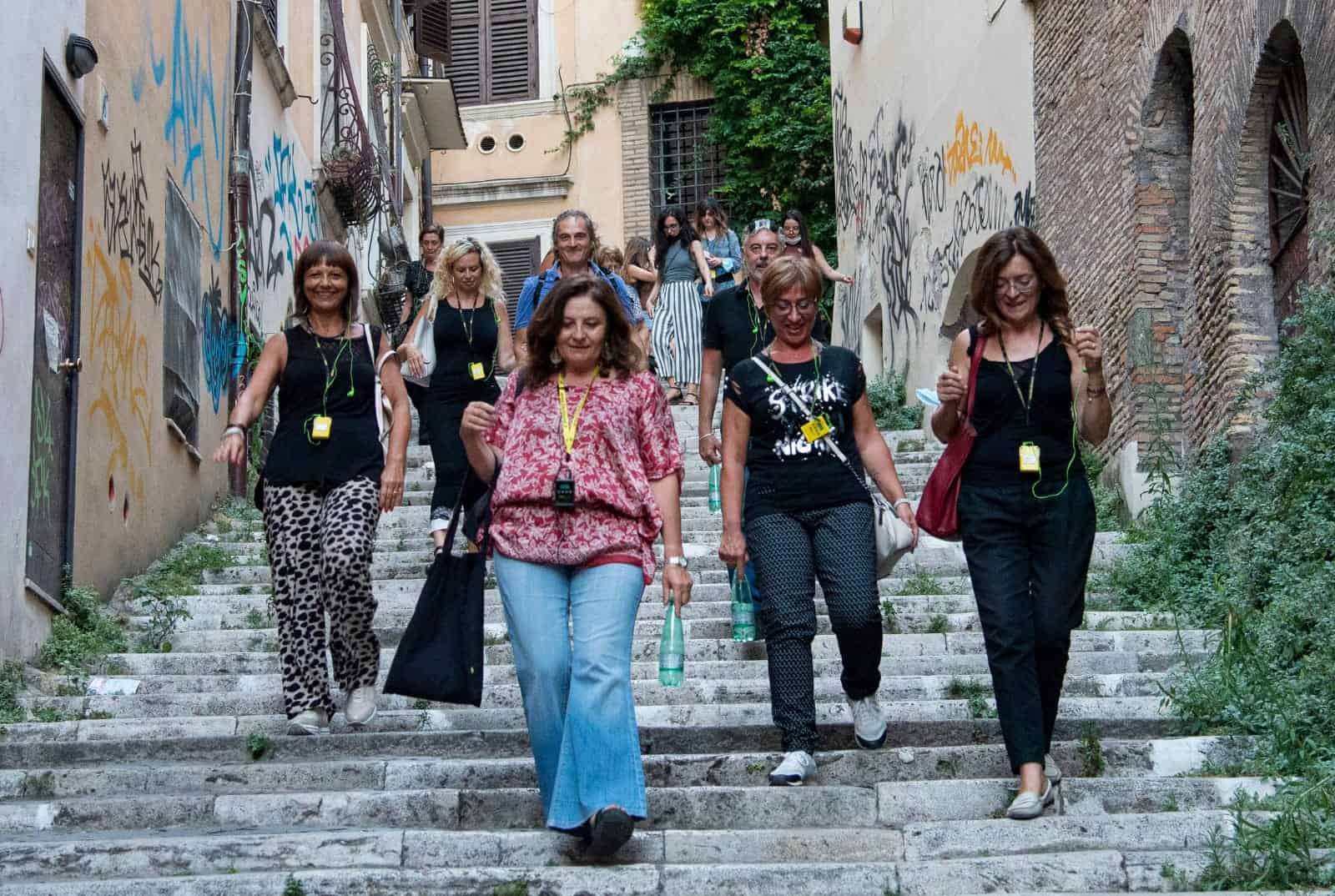Rome tour guides: Dying a slow Covid economic death

Rome tour guides have become flexible
The words “Covid” and “coronavirus” were just entering the Italian vocabulary in March of last year. “Pandemic” would soon follow. But when another angry English word surfaced like a shark chasing snorkelers, it hit one Italian industry harder than others.
Lockdown.
For many, it meant homeschooling. For others it meant a temporary business closure. But for tour guides and tour companies in Italy, the ramifications stretched from their homes to all corners of the earth.
“We knew we’d be the first one to stop and the last one to restart,” Rome tour guide Nadia Cicchinelli said.
Cicchinelli sat at Il Siciliano, a Sicilian-style cafè in Piazza di San Cosimato, a sprawling, leafy square in Rome’s hip Trastevere neighborhood. It’s the area Nadia loves taking tourists, showing them the history hidden behind the neighborhood’s rollicking nightlife.
A year ago, as Italy became the first country Covid poleaxed, people were dying in their beds and in their bank accounts. The government, many felt, was asleep at the switch.
It’s why Rome tour guides and the tour guide association, Associazione Guide Turistiche Abilitate (AGTA), organized a protest that March in front of the Parliament building in Rome.
Statistics
They asked the state for special support as the tourist industry is a specially important industry, making up 14 percent of Italy’s gross domestic product. Yet it was crumbling and tour guides were crawling toward life support.
Last year Rome’s overnight stays dropped 80 percent, Forbes reported.
According to the World Travel & Tourism Council, last year Italy lost 120 billion in the tour industry. It’s why at the Parliament building, Nadia took the microphone and addressed the politicians inside.
“I said, ‘This is a scandal!’” she said. “We are the country of Michelangelo, or Raphael, of Leonardo Da Vinci and we don’t care of our cultural heritage! You abandoned us to our destiny! You have no idea what tourism means! Image! Promotion!”
Later that day, tour guides from all over Rome gathered in front of the Pantheon, with umbrellas, and did a flash mob video of “Singing in the Rain.”
Whimsy is a nice fallback when your world is collapsing. In Rome, the tour guides faced more uncertainty than most. Other businesses could count on locals returning when the lockdown ended. But when would tourists fly into Italy after headlines of skyrocketing death rates and villages wiped out by the virus?
Picture the scene in “Jaws” when the mayor tried luring people back into the water. Last year nearly 84 million hotel reservations were cancelled in Italy. The tour guides were left with nothing and their calendar didn’t have enough pages for them to look ahead.

“If I didn’t have the backup, I would’ve had to go back to America,” said Inger Rasmussen, a Rome tour guide from Detroit. “I couldn’t afford my rent.”
I sat with Inger at Enoteca Bortone, which could win an award for Rome’s smallest wine bar. White flowers rim the door and potted plants line the entrance.
We sat at the lone outside table on Via di Monserrato, one of the charming, narrow, cobblestone streets near Campo de’ Fiori in Centro Storico. Cool, crisp glasses of white Traminer were refreshing on a postcard-perfect day in the 70s.
Inger’s story
A freelance tour guide for 20 years and a Rome resident since 1999, Inger (ingerras@yahoo.c9m) has had one tour since October. She had two tours in July. That’s four tours in nearly a year. She’s lucky. Her boyfriend is a high school teacher who kept working remotely.
“I feel like I’ve been in hibernation,” she said. “At this moment in time, I see some light at the end of the tunnel and I’m kind of waking up. I’m sticking my head up: What is the situation right now?”
Well, it’s much better. Italy’s average daily number of new cases has dropped from 34,283 in the week ending Nov. 20 to 1,635 last week. It’s average number of daily deaths has gone from 440 in the week ending April 15 to 59.
But the dreaded Delta virus strain has crept across our border and Italy has seen drops before. People also know it will be a long time before economics begin catching up to the losses.
“This isn’t over yet,” Inger said.
Nadia’s clients were mostly American and French. A Rome native and tour guide for 21 years, Nadia (Igea_2006@yahoo.it) said the AGTA has monopolized the Italian tourist market for the last three decades. With Americans blocked and France having its own problems, her source of income had run dry.
“No. Nothing,” she said. “You’re asking yourself normal questions like, How can I pay for my house? Would the money I have be enough for one year? Two years?”

Tour companies
Then there’s the case of tour companies who are in charge of tour guides and their lives. Rob Allyn, a Stamford, Conn., native, moved to Rome in 1997 and started Through Eternity Tours (www.ThroughEternity.com) with a business partner in 1999. He said for 2020, the company that ran the Colosseum required all tickets to be prepaid. Allyn paid 80,000 euros.
Then the pandemic hit. Nearly his entire clientele is American.
“I immediately had 80,000 euros blocked from me,” he said by phone. “I could not get that money back from them. Other companies had sent millions from all the tour operators in Rome. It effectively crippled everybody. Not only did I no longer have access to 80,000 euros, I had to deal with clients either cancelling or saying, ‘OK, we’ll postpone the trip.’ It was devastating.”
Allyn said he went $500,000 in debt and cut his staff from seven to three. The Colosseum would only give them vouchers good for a year and a half from when the pandemic started in March 2020.
With the pandemic slowing, the time period extended another 18 months to June 2023. For clients who paid for Through Eternity’s many other tours, the company said they could come to Rome for the tour any time in the future.
“A lot of people were very understandable,” he said. “Some were not. We had to deal with a lot of contested charges. The operative word was survival. If we couldn’t survive we couldn’t have paid people back. We were put in an impossible situation.”
Personally, he had to ask his landlord for a break.
“There’s a humiliation that comes with that,” he said. “The landlord was getting on my case for not paying the condo fees. I have to pay my staff. That’s more important than to pay someone to sweep my hallway.”
In some ways, Rob was lucky. Through Eternity Tours, which I briefly worked for as a website contributor four years ago and it’s a superb company, is a boutique business. Bigger Rome tour companies lost millions.
Government steps up
The Italian government, however, did step up. Maybe they heard Nadia’s call for help outside the Parliament or have a certain affliction for “Singing in the Rain.” The state recognized tourism as a special needs business and gave a ristoro.
While many Italians who lost their jobs received a few centesimi, Nadia said she received 8,000 euros last year and new prime minister Mario Draghi this year gave another 1,800 to those in the industry.
Inger received 7,000 euros over Christmas, then 3,000 euros from back taxes plus two payments of $600 each from the American stimulus.
“I’ve been on a budget but it’s starting to run out,” Inger said.
Allyn’s company qualified him for a $150,000 Small Business Administration loan from the U.S. on which he must pay interest. His father, who also worked in a travel agency, helped him with a home equity loan but a parent’s help only goes so far.
“My father asked when is it going to be enough,” Rob said. “How much is enough? It never will be enough. I won’t stop. This company I’ve worked in for 20 years. I won’t give up.”

Nadia’s plan
Nadia had her own solution. In June 2020, she had an idea. She couldn’t compete with the AGTA for incoming Italian tourists but people she knew in Rome needed an escape from the suffocating lockdowns.
Sometimes I’m shocked that I’ve seen more of Rome than people who’ve lived here all their lives.
“The people they can not travel around so they will travel inside their city, in their neighborhood,” Nadia said. “So what I really tasted there was a new market in cultural tourism. This was a great intuition. But I started by chance with some friends.
“They saw me. They were worried about me. They said, ‘Nadia, don’t worry. Take me. Take me to the Vatican Museums. I’ve never visited.’ This was the starting point.”
She started with four or five people and then word got around. She took them to little-known places in Rome such as the Sant’Onofrio Convent in Trastevere, the Monti neighborhood near the Colosseum, the Jewish Ghetto.
She did walking tours of street art in Ostiense and along the banks of the Tiber River and Aqueduct Park. They walked along Appian Way, the original road where Spartacus and his slave revolt met their grisly end.
“People after the lockdown, they want to walk,” she said. “They want air.”
Except for the second lockdown in March, Nadia has done tours for locals every weekend for a year.
What the future holds
Tour guides in Rome watch Italy’s Covid case and death curves with the intensity of air traffic controllers.
With Italy’s curves drastically dropping. the government is allowing tourists from EU countries to visit with only a negative test.
It decided Americans can come if they’re vaccinated and take Covid-free flights, although dates have yet to be confirmed and the situation remains in flux.
However, that air you feel is the AC units cranking as summer heat begins to sock in Italy. It is not the tour guides’ sigh of relief. Besides her locals, Nadia has only one booking: In October.
The problem with Italy’s rules is they seem to change as much as the curves do.
“Italy so far has not given sure information, straight information about the reopening about the lockdown, about the conditions of the testing,” Nadia said. “Now they are more clear but it’s too late. The government doesn’t understand that tourism isn’t something you can do at the last minute. They need time.”
Added Inger: “There have been Americans who’ve come here and had reason to come here but for tourists? It takes a while to get their act together, to get the time off to plan. Americans generally don’t go, ‘Let’s go to Rome next week.’ It’s ‘Let’s go to Rome in October.’”
With summer starting, few tourists have trickled in and they’ve found Rome as few ever see it: Quiet, uncrowded and nearly all restaurants and bars with outdoor seating, remains from early restrictions on indoor service.
“Take this unique occasion to see the Vatican Museums empty,” Nadia says in her pitch.
But for tour guides, bigger is better. They’ve blown off hope for this summer.
Maybe in the fall business will pick up. They are counting on 2022 for their comeback.
“Basically,” Nadia said, “we lost another year.”
Meanwhile, they’re all taking reservations for tours of any place you want to see.
Rob even gave a tour of the Colosseum last week with seven American Airlines crew members who had a long layover.
And like the smiles they always have on their faces, even when describing gladiator battles in the Colosseum, the tour guides still gamely put a smile on this.
“I’ve seen other tour guides,” Inger said. “I’ve run into them on the street: ‘How are you doing?’ I saw one and she said, ‘We survived! Can you believe it? We survived!’”

